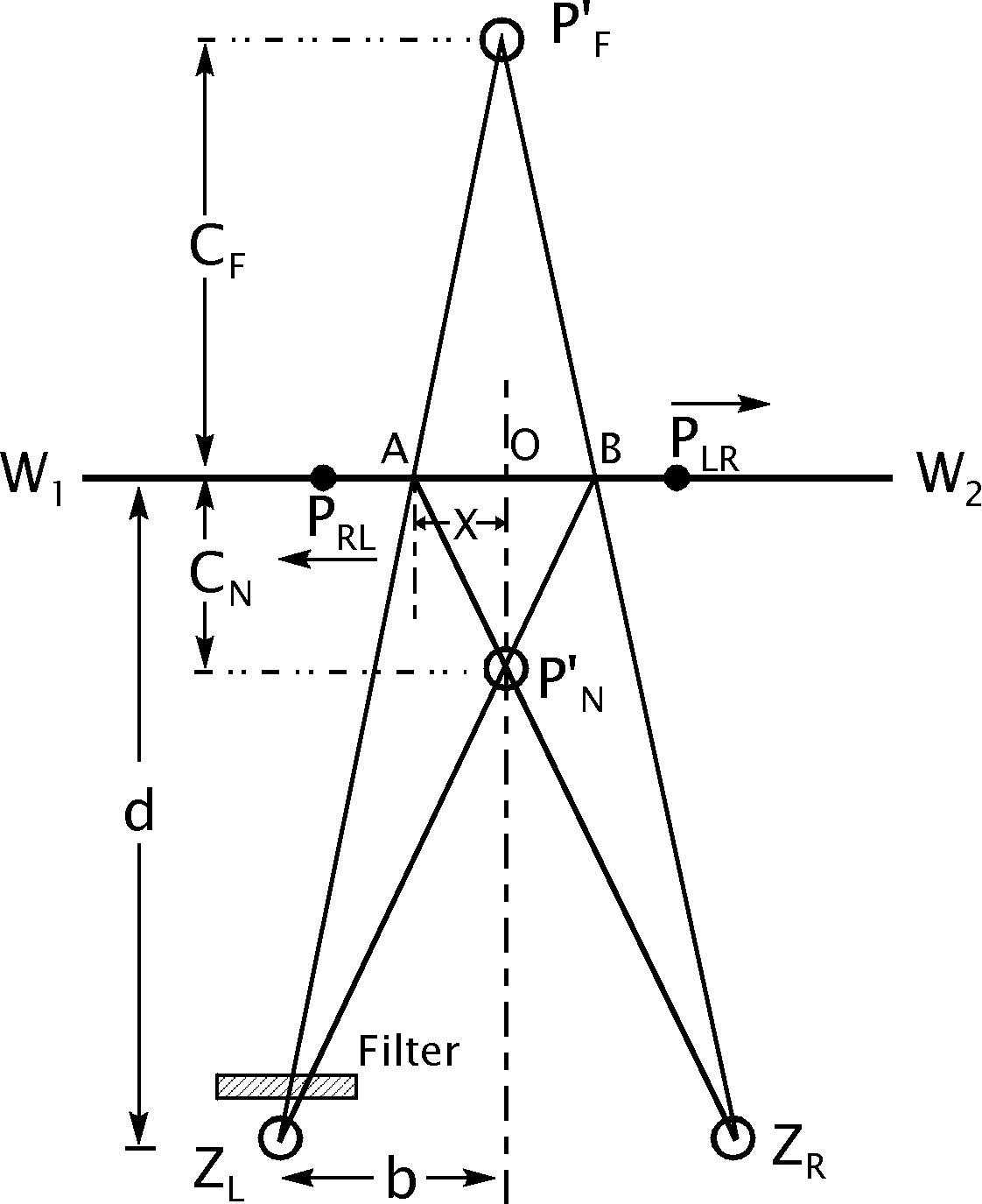
Copyright (c) 1960, Alfred Lit. Permission of the author and
the publisher is granted to make (download) a single copy of this explanation
for personal, noncommercial use. All other rights are reserved.
Modification or redistribution of all or part of this work in any form is
forbidden: Please contact the author for permission to
post or copy this work for any purpose.
This explanation is adapted from Lit (1960) on target thickness. Please refer to that paper, posted elsewhere at this web site, for further information. Lit's (1949) classic, also posted at this web site, explains the geometry in full detail.
The stereoscopic effect with which the present experiment deals was first described and analyzed by Pulfrich in 1922. A target which is oscillating at eye level in a frontoparallel plane appears to rotate out of its plane of oscillation when a neutral or colored filter is placed in front of one of the observer's eyes.
The depth effect becomes noticeable at some threshold difference of binocular retinal illuminance and progressively increases as the difference of binocular retinal illuminance is increased.
Pulfrich (following a suggestion by Fertsch) accounted for these depth displacements in terms of a difference in the hypothesized visual latent periods of the two eyes. The visual latent period of each eye was assumed to be a reciprocal function of the prevailing level of retinal illuminance. Thus, the eye covered with the filter presumably "signals" a position of the oscillating target that lags behind the position signaled by the uncovered eye. Hence, at any given moment, synchronous binocular signals are provided by pairs of noncorresponding retinal points in the two eyes, and the magnitude of the stereoeffect theoretically depends on the amount of the retinal disparity produced as a consequence of the difference in the visual latent periods of the two eyes.
In Lit's work, the appearance of the targets to an observer, with the upper target in motion, would be as in this figure, or in this animation:

Consider the geometry, viewed from above, shown in in the next figure, of a target that is oscillating in a frontoparallel plane with constant linear velocity V for the central portion of its stroke.

The linear path of the target in its plane of oscillation is denoted by W1W2. The distance d of the plane of oscillation is measured from the midpoint of the line ZLZR which joins the centers of rotation of the two eyes.
As indicated, the filter is placed in front of the left eye. The point PF' represents the far position in the vertical median plane at which the oscillating target, at point PLR, is localized by the observer as the target moves from left to right. The point PN' represents the near position of localization in the vertical median plane when the target, moving from right to left, has reached the point PRL. The distance OPF' designates the magnitude of the far displacement CF. The distance OPN' designates the magnitude of the near displacement CN.
In accordance with the laws of binocular space discrimination, lines of sight from each eye are drawn through the two respective points of target localization, PF' and PN'. The intersection points of the lines of sight with the line W1W2 are designated by A and B, and these points theoretically mark the respective positions in the path of the oscillating target at which onset of stimulation occurred in each of the two eyes.
Thus, when the target is moving from left to right and appears to be located at the far position PF' towards which the eyes are converged, the onset of stimulation for the right eye occurs when the target (at PLR in the diagram) is located at point B, and the onset of stimulation for the left eye, covered by the filter, occurs when the target is located at point A, a bit farther behind in its path.
The time taken for the target to move from B to PLR represents the magnitude of the visual latent period of the right eye, and the time taken for the target to move from A to PLR represents the slightly longer visual latent period of the left eye.
Consequently, the time taken for the target to move from A to B
represents the difference, ![]() , in the
visual latent periods of the two eyes, based on the far position of target
localization, PF'. It follows by the same reasoning that when
the target is moving from right to left and appears to be located at the near
position, PN', towards which the eyes are now converged, the time
taken for the target to move from B to A represents the difference,
, in the
visual latent periods of the two eyes, based on the far position of target
localization, PF'. It follows by the same reasoning that when
the target is moving from right to left and appears to be located at the near
position, PN', towards which the eyes are now converged, the time
taken for the target to move from B to A represents the difference,
![]() , in the visual latent periods of the
two eyes, based on the near position of target localization,
PN'. An animation may help visualization of these quantities.
, in the visual latent periods of the
two eyes, based on the near position of target localization,
PN'. An animation may help visualization of these quantities.
It can be readily seen from similar triangles in the diagram above that for target localizations at PN' and PF', respectively:
where X=1/2 the distance from A to B, and b=1/2 the distance between the centers of rotation of the two eyes.
For an oscillating target moving with constant linear velocity V, the time taken for the target to pass through the distance X is given by the formula
The time taken for the target to move from A to B (or B to
A) represents the difference, ![]() , in
the visual latent periods of the two eyes. Since
, in
the visual latent periods of the two eyes. Since ![]() =2t, we obtain from Eq. (2)
=2t, we obtain from Eq. (2)
By substituting for X the respective expressions given in Eq. (1), we
finally obtain the following relationships between the experimentally determined
near and far displacements (CN and CF) and the
corresponding near and far latency differences (![]() and
and ![]() ):
):

It should be noted from purely geometric considerations that, for any constant
difference of binocular retinal illuminance, the magnitude of the stereoscopic
effect as measured by CN and CF should
progressively increase as the linear velocity of the oscillating target is
increased, but the corresponding calculated values of ![]() and
and ![]() should remain
constant for all target velocities used.
should remain
constant for all target velocities used.
Back to Pulfrich Effect Home. University Privacy Policy
The Pulfrich Effect, SIU-C. Last updated 2000-08-09